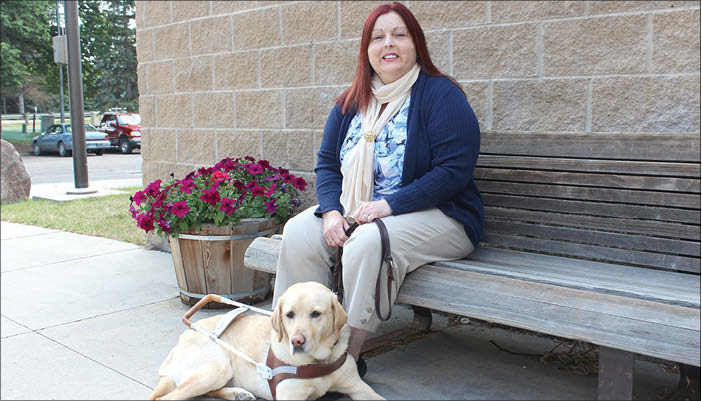Five years ago on July 14, Sherry Shirek came to North Dakota from New York. Love brought her here. Helping our community understand and provide accessibility is her mission here.
Shirek lost her sight to diabetes complications as a young woman. Because she lived in a state where doctors did mandatory reporting when someone became legally blind, she was “swooped up” and provided residential education in how to live as a legally blind person.
She was taught how to walk around Boston with her white cane, learned Braille, how to be independent. Living in a residential facility for 16 weeks gave her a support network. “The experience gave me my life back,” she says. Shirek and her second guide dog, Millie, are now a team.
Shirek is passionate about the arts because of her experiences at art museums and galleries on the East Coast. That passion brought her to the Historical and Cultural Society of Clay County where she works to make exhibits, displays, shows and activities accessible.
“There is a commitment to do more than wheelchair ramps and basic Americans with Disabilities Act requirements. The Hjemkomst actively works to be fully accessible. Maureen (Kelly Jonason, HCSCC executive director) invited my husband, Jesse, and me to be part of this,” she said. “She took us to a meeting where the concentration was on audio description,” Sherry said. After that, Sherry became a consultant at HCSCC.
HCSCC and the Arts Partnership in the community, with help from the Minnesota Council on the Arts, are learning to use many methods to increase access to art. Everything from large print, sign language, respite rooms, audio recordings, and touch – all senses – is explored and activated where possible.
“We share resources and work together, especially with the July audio description training coming up,” Shirek adds.
Audio Description Solutions will do a two-and-a-half day training session July 22-24. Audio description is commentary narrative to describe visual elements of live performances, museum exhibits, visual art, films, television and multi-media to provide accessibility to people who are blind or have low vision. Friday from 7-9 p.m. is free of charge and open to anyone interested in audio description. Contact the HCSCC to register for the training.
When celebrations like Pangea, the Scandinavian Festival, the Midwest Viking Festival and other events happen, accessibility is important. History and culture come alive when people can participate.
HCSCC is “going for universal access. We’re looking at being more accessible online, I Pods, everything. Technology is great,” Shirek says.
The Historic Comstock House is part of the HCSCC, too. This summer Beca Livermont, an almost senior at West Fargo High School, is an intern. She mapped the house to see what can be done to make it more accessible.
Matt Eidem, site manager for the Comstock House and director of museum operations, notes that all tours are guided at the House and that a universal accessibility plan is part of Beca’s work. “As a national historic site, the Comstock House is grandfathered into ADA law. We make accessibility a priority but we cannot make permanent changes at the house. Even ramps have to be temporary.”
On July 21, Jane Stromberg, an art education student from Minnesota State University Moorhead, will teach a watercolor class for kids in the Comstock House yard from 3-5 p.m. The class is for about 15 students. Email matt.eidem@HCSmuseum.org, for more information.
The Comstock House is open from 1-4 p.m. weekends, Memorial Day through October.
A lot is happening at the HCSCC.
Dear to Sherry is the current exhibit about Helen Keller. The national touring exhibit, “Child in a Strange Country: Helen Keller and the History of Educating People Who are Blind or Visually Impaired” will be at the museum through Nov. 1.
“The exhibit explores reading, science, math and geography, using Keller’s educational journey as a lens. There are tactile reproductions and authentic artifacts to uncover the roots of modern education for children with vision loss,” Kelly Jonason said.
The exhibit is designed to be fully accessible. Each section includes six panels mounted with tactile reproductions or touchable examples of real artifacts. Each concludes with a sit-down touch table with interactive games and activities that spur the sensory imagination. Labels are available in large-print, Braille and audio versions.
Kelly Jonason reached out to Lions Clubs in the area to help support the exhibit. Lions became Knights of the Blind after Keller implored the group at its 1925 convention to become “knights of the blind in the crusade against darkness.”


